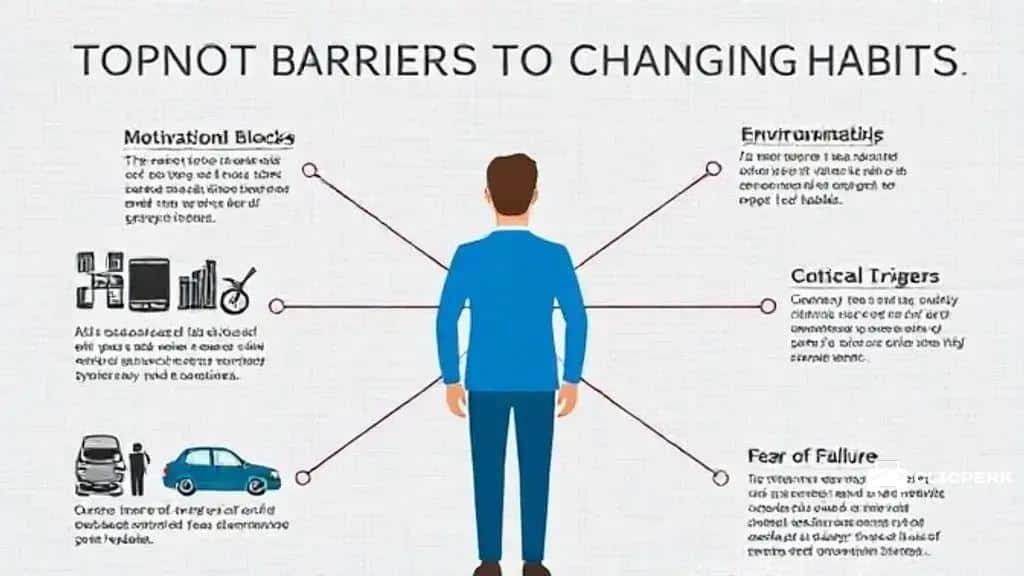The psychology of habit formation and change

Anúncios
The psychology of habit formation and change explores how habits are created, modified, and maintained, offering strategies for effective habit transformation and real-life examples of successful behavioral change.
The psychology of habit formation and change can significantly impact your daily life. Have you ever wondered why some habits stick while others fade away? This article delves into the intriguing mechanisms behind habit creation and how you can leverage them for positive change.
Anúncios
Understanding the science of habits
Understanding the science of habits is essential for anyone looking to improve their daily routines. Habits are powerful and often operate automatically, influencing our decisions and actions more than we realize. By exploring how habits form and change, we can harness this knowledge to create positive transformations in our lives.
What Are Habits?
Habits are behaviors that become automatic through repetition. When we perform a task repeatedly, it becomes engrained in our brain, making it easier and faster to execute. This automaticity is primarily due to the brain’s desire to conserve energy. Once a behavior becomes a habit, it requires less conscious thought.
The Habit Loop
To understand how habits work, we need to familiarize ourselves with the habit loop. This loop consists of three components:
Anúncios
- Cue: The trigger that initiates the habit.
- Routine: The habitual behavior itself.
- Reward: The positive outcome that reinforces the habit.
This loop not only illustrates how habits are formed but also highlights how they can be changed. By modifying any part of the loop, particularly the reward, we can influence our habits over time.
Neuroscience plays a huge role in understanding habits. Studies show that repeated actions lead to changes in the brain’s structure, specifically in the basal ganglia. This area is crucial for forming and regulating habits. Over time, as a habit is reinforced, the brain requires less activity in the prefrontal cortex, which is responsible for decision-making.
Importance of Awareness
Being aware of our habits is the first step towards improvement. Acknowledging the cues and rewards associated with our routines allows us to see where we can make positive changes. For example, if stress triggers a habit of reaching for a snack, finding an alternative response, such as taking a walk, can be a healthier option.
Ultimately, understanding the science of habits equips us with the tools needed to create lasting change. Whether we aim to adopt new habits or eliminate unproductive ones, knowledge about the underlying processes is crucial.
The stages of habit formation
The stages of habit formation are crucial for understanding how we develop routines and behaviors that stick. Recognizing these stages can empower us to form better habits and break free from unproductive ones. Generally, there are three key stages in the habit formation process.
1. Decision and Motivation
The first stage involves recognizing the need for a change in behavior and deciding to take action. It often starts with a specific goal. Wanting to exercise more or eat healthier represents this stage. Having a strong motivation is essential; it drives you towards making the change.
2. Learning and Repetition
After the initial decision, the next step is the learning phase. This is where repetition plays a significant role. When you consistently practice a new behavior, your brain starts forming neural pathways. For example, if you commit to jogging every morning, the more you do it, the easier it becomes. This repetition solidifies the behavior into a habitual routine.
- The brain begins to recognize the cues associated with the behavior.
- The routine becomes more automatic with practice.
- Positive reinforcement helps in maintaining motivation.
This phase can be challenging, as it often requires persistence and overcoming initial discomfort. During this time, you may struggle with inconsistency, but pushing through is vital for long-term success.
3. Integration and Automaticity
The final stage is when the habit becomes integrated into your daily life, almost automatically. You no longer have to think about it; it simply becomes part of your routine. At this point, you have internalized the behavior so much that it feels second nature. The key to success lies in reaching this stage, where the effort is significantly reduced.
Understanding these stages offers valuable insights into how to foster positive behavioral changes. Whether you’re trying to quit smoking, develop a reading habit, or adopt a healthier lifestyle, recognizing where you are in the process can guide your actions.
Common barriers to changing habits

Changing habits can be a challenging journey due to various common barriers that people face. Understanding these obstacles is crucial for overcoming them and achieving lasting change. Many struggle with deeply rooted behaviors that seem impossible to shift.
1. Lack of Motivation
One significant barrier is a lack of motivation. Without a clear reason to change, it’s easy to stick with familiar habits, even if they are unhealthy. Setting specific goals can help increase motivation and create a sense of purpose.
2. Environment and Triggers
The environment plays a huge role in shaping our behaviors. If you are surrounded by triggers that lead to unproductive habits, it becomes much harder to change. For example, having junk food readily available can make healthy eating more difficult. To combat this, create a supportive environment that aligns with your goals.
- Identify triggers that lead to unwanted behaviors.
- Modify your space to support new habits.
- Surround yourself with positive influences.
Another challenge is the discomfort associated with change. When modifying habits, you may encounter feelings of unease and uncertainty. This discomfort can discourage you from continuing. Remember, every change takes time, and it’s normal to feel out of your comfort zone initially.
3. Fear of Failure
Many people fear failure, which can prevent them from even attempting to change. This fear often leads to procrastination or giving up entirely when faced with setbacks. It’s important to reframe your mindset – view failures as learning experiences rather than endpoints.
Realizing that change is a process can help alleviate some of this pressure. Celebrate small victories along the way to build confidence. Acknowledging progress, no matter how minor, can motivate you to push through obstacles.
Effective strategies for lasting change
Implementing effective strategies for lasting change in habits can greatly improve your personal and professional life. These strategies help ensure that new behaviors stick over time, leading to sustainable improvements.
1. Start Small
When aiming for change, it’s important to begin with small, manageable steps. Large goals can feel overwhelming, making it easier to give up. Starting small allows you to build momentum gradually. For example, if you want to start exercising, begin with just ten minutes a day. This can lead to longer workout sessions as you become more comfortable.
2. Set Specific Goals
Another key strategy is to set specific, measurable goals. Instead of saying, “I want to eat healthier,” try, “I will eat two servings of vegetables at dinner each night.” Specific goals provide clarity and make it easier to track your progress.
- Use the SMART criteria: Specific, Measurable, Achievable, Relevant, Time-bound.
- Break larger goals into smaller steps for easier management.
- Regularly review and adjust your goals as necessary.
While changing habits, accountability can also play a vital role. Sharing your goals with friends, family, or a mentor creates a support system. When others are aware of your goals, they can encourage you, offer help, and hold you accountable.
3. Build a Support System
Having a network of support can make the process of changing habits more enjoyable. Join a community or group that aligns with your goals, such as a fitness class or book club. Engaging with others who share similar interests fosters a sense of belonging and motivation.
Visualization techniques can enhance your ability to stick with new habits. Imagine yourself achieving your goals and experiencing the benefits of your desired changes. This mental imagery can reinforce your commitment to lasting change. Remind yourself regularly of why you started and the positive outcomes you aim to achieve.
Real-life examples of successful habit change
Real-life examples of successful habit change can inspire anyone looking to transform their behaviors. Learning about others who have achieved their goals reminds us that change is possible. Let’s explore a few remarkable stories.
1. The Fitness Journey
Many individuals start with small changes to their routines, such as walking daily. For instance, Sarah, an office worker, decided to take the stairs instead of the elevator. This small shift led to her gradually increasing her activity level. After a few months, she joined a local gym and started a regular workout routine. Eventually, Sarah completed her first 5K run, demonstrating how a simple habit can snowball into significant achievements.
2. Healthy Eating Transformation
Another compelling example is the story of John, who struggled with unhealthy eating habits. He realized that emotional eating was a problem in his life. To combat this, he began keeping a food journal to track his meals and feelings. This awareness helped him identify triggers for his eating habits. Over time, he replaced junk food with healthier snacks, and he learned to cook nutritious meals. John’s personal journey shows that understanding the root of habits is key to changing them.
- Documenting progress can keep motivation high.
- Identifying triggers is crucial for making changes.
- Healthy habits can flourish from awareness and practice.
In yet another case, Maria decided to reduce her screen time in favor of reading more books. She set a goal of reading one book per month. By establishing a specific target and dedicating time each day to read, she not only expanded her knowledge but also enhanced her focus and creativity. This shift positively impacted her productivity at work as well.
3. Gradual Habit Development
Many successful individuals attribute their changes to setting realistic goals. For example, David, who aimed to drink more water, started by keeping a bottle on his desk. He made it a point to refill it throughout the day. Over several weeks, this small action transformed into a daily habit, significantly improving his hydration levels. David’s example illustrates how minor adjustments can lead to substantial lifestyle changes.
These stories emphasize that effective habit change often begins with small, manageable steps and a willingness to adapt. By learning from others, we can find inspiration and practical strategies to apply in our own lives.
In summary, understanding the psychology of habit formation and change opens the door to transforming your life. By learning about the stages of habit creation and the barriers to change, you can better navigate your personal journey. Employing effective strategies and drawing inspiration from real-life examples can motivate you to stick with your new habits. Remember, change takes time, but small steps lead to meaningful progress. Stay committed, be patient, and celebrate your successes along the way!
FAQ – Common Questions About Habit Formation and Change
What is the habit loop?
The habit loop consists of three components: cue, routine, and reward, which explains how habits are formed and maintained.
How can I break a bad habit?
To break a bad habit, identify triggers, replace the behavior with a positive action, and stay consistent with your new routine.
Why is motivation important in habit change?
Motivation provides the drive to initiate change; without it, it’s harder to commit to new habits or stick to them long-term.
Can small changes lead to big results?
Yes, starting with small, manageable changes can build momentum and lead to significant improvements in your habits over time.





